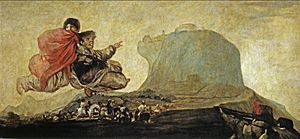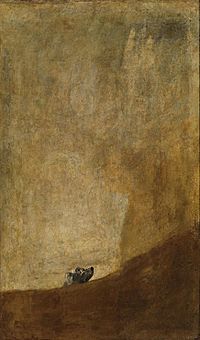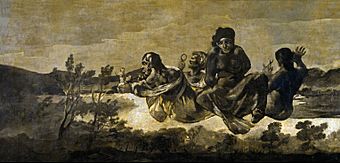Asmodea facts for kids
Quick facts for kids Asmodea / Fantastic Vision |
|
|---|---|
| Spanish: Asmodea / Visión fantástica | |
 |
|
| Artist | Francisco Goya |
| Year | c. 1820–1823 |
| Medium | Oil on gesso transferred to linen |
| Dimensions | 127 cm × 263 cm (50 in × 104 in) |
| Location | Museo del Prado, Madrid |
Asmodea or Fantastic Vision (Spanish: Visión fantástica) is a famous painting by the Spanish artist Francisco Goya. He likely finished it between 1820 and 1823. The painting shows two people flying high above a landscape. A large, flat-topped mountain stands out in the scene.
Asmodea is one of Goya's 14 Black Paintings. These were his last big series of artworks. He painted them directly onto the walls of his house. This house was called the Quinta del Sordo, outside Madrid. Goya created these works when he was feeling very sad and unwell.
Goya never gave names to any of these "Black Paintings." So, we don't know what he meant by them. He probably didn't want many people to see them. The name Asmodea was given later by his friend, Antonio Brugada. It likely refers to a powerful demon king named Asmodeus. This demon appears in old stories, like the Book of Tobias. Asmodeus also shows up in the Greek myth of Prometheus. In that story, the goddess Minerva takes him to the Caucasus mountains.
What the Painting Shows

The painting features two figures floating in the air. One is a man, and the other is a woman. They are flying above a wide landscape. The woman wears a white dress with a red-rose colored robe over it. Both figures look scared. The woman covers part of her face with her robe. The man's face shows deep worry.
They are looking in different directions. The man points towards a town on top of a mountain. This mountain is on the right side of the painting. Some art experts think the mountain looks like Gibraltar. Gibraltar was a safe place for Spanish people who supported new ideas after a war.
In the front of the painting, you can see a line of soldiers. They look like the French soldiers from Goya's 1814 painting, The Third of May 1808. These soldiers are aiming at a group of people in the distance. This group is traveling with horses and wagons. They might be people running away from the war with France. Goya showed the suffering of war victims in his series The Disasters of War.
Meaning and Style

The sky in Asmodea has a pale, almost sickly color. This is similar to the sky in another "Black Painting" called The Dog. Asmodea also shares similarities with Atropos and A Pilgrimage to San Isidro. In these paintings, Goya uses a special trick to change how you see things. It's like an oval shape that makes some parts look closer.
For example, the man's robe in Asmodea makes him seem very close to you. He appears much closer than the woman flying next to him. Like Atropos, this painting is one of the few from the series where we can guess its meaning. We can do this by looking at old stories and myths that inspired Goya.
Where to See It
Goya first painted Asmodea on cloth that was hung on a wall. Like most of the "Black Paintings," he painted it over an earlier version of the scene. Goya placed this artwork on the side walls of the upper floor of his house, the Quinta del Sordo.
Later, the painting was carefully moved from the cloth to a canvas. Today, you can see Asmodea on display. It is shown with the other "Black Paintings" at the Museo del Prado in Madrid, Spain.
See also
 In Spanish: Visión fantástica o Asmodea para niños
In Spanish: Visión fantástica o Asmodea para niños
- List of works by Francisco Goya

